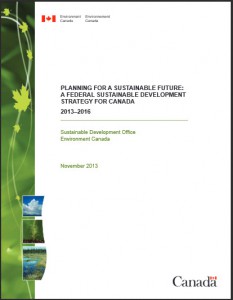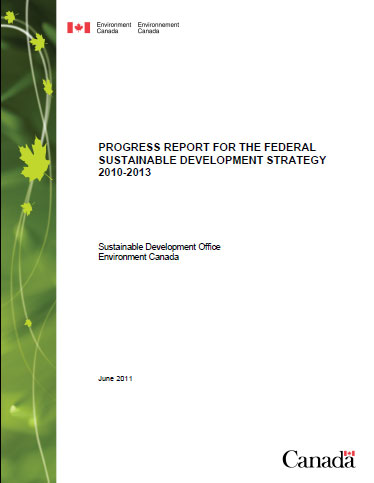Canada’s Sustainable Development Strategy
 First published in October 2010 and updated in 2013, the Federal Sustainable Development Strategy (FSDS) is intended to provide an integrated whole-of-government picture of actions to achieve environmental sustainability, acknowledging that the old system of individual strategies by key ministries did not work.
First published in October 2010 and updated in 2013, the Federal Sustainable Development Strategy (FSDS) is intended to provide an integrated whole-of-government picture of actions to achieve environmental sustainability, acknowledging that the old system of individual strategies by key ministries did not work.
Actually, the new approach isn’t much better, falling well short of being an integrated approach to sustainable development. It reads more like an environmental management strategy, focusing on key areas of concern for the government.
Goals, targets, and implementation strategies are organized under four priority themes:
- Addressing climate change and clean air,
- Maintaining water quality and availability,
- Protecting nature and Canadians, and
- Shrinking the environmental footprint – Beginning with government.
This is the list of goals and targets in the strategy.
Goal 1: Climate Change
In order to mitigate the effects of climate change, reduce greenhouse gas emission levels and adapt to unavoidable impacts.
Target 1.1: Climate Change Mitigation
Relative to 2005 emission levels, reduce Canada’s total GHG emissions 17% by 2020.
Target 1.2: Climate Change Adaptation
Facilitate reduced vulnerability of individuals, communities, regions and economic sectors to the impacts of climate change through the development and provision of information and tools.
Goal 2: Air Pollution
Minimize the threats to air quality so that the air Canadians breathe is clean and supports healthy ecosystems.
Target 2.1: Outdoor Air Pollutants
Improve outdoor air quality by ensuring compliance with new or amended regulated emission limits by 2020 and thus reducing emissions of air pollutants in support of AQMS objectives.
Target 2.2: Indoor Air Quality
Help protect the health of Canadians by providing health-based guidance and tools to support actions to better manage indoor air quality.
Goal 3: Water Quality and Water Quantity
Protect and enhance water so that it is clean, safe and secure for all Canadians and supports healthy ecosystems.
Targets to Support Safe and Secure Water Systems
Target 3.1: On-Reserve First Nations Water and Wastewater Systems
Increase the percent of on-reserve First Nations water systems with low risk ratings from 27% to 50% by 2015. Increase the percent of on-reserve First Nations wastewater systems with low risk ratings from 35% to 70% by 2015.
Target 3.2: Drinking Water Quality
Help protect the health of Canadians by developing up to 15 water quality guidelines/guidance documents by 2016.
Targets to Protect and Restore Aquatic Ecosystems
Target 3.3: Great Lakes – Canadian Areas of Concern
Take federal actions to restore beneficial uses for delisting five Canadian Areas of Concern and to reduce the number of impaired beneficial uses in the remaining Areas of Concern by 25% by 2018.
Target 3.5: St. Lawrence River
Take federal actions to reduce pollutants in order to improve water quality, conserve biodiversity and ensure beneficial uses in the St. Lawrence River by 2016.
Target 3.6: Lake Simcoe and South-eastern Georgian Bay
Reduce an estimated 2000 kg of phosphorus loadings to Lake Simcoe by 2017, which will support the Province of Ontario’s target to reduce phosphorus inputs into Lake Simcoe to 44 000 kg/year by 2045. Reduce an estimated 2000 kg of phosphorus loadings to south-eastern Georgian Bay watersheds by 2017.
Target 3.7: Lake Winnipeg Basin
By 2017, reduce phosphorus inputs to water bodies in the Lake Winnipeg Basin, in support of the Province of Manitoba’s overall plan to reduce phosphorus in Lake Winnipeg by 50% to pre-1990 levels.
Targets to Prevent Pollution and Manage Waste
Target 3.8: Marine Pollution – Releases of Harmful Pollutants
Protect the marine environment by an annual 5% reduction in the number of releases of harmful pollutants in the marine environment by vessels identified during pollution patrol from 2013-16.
Target 3.9: Marine Pollution – Disposal at Sea
Ensure that permitted disposal at sea is sustainable, such that 85% of disposal site monitoring events do not identify the need for site management action (such as site closure) from 2013-16.
Target 3.10: Agri-Environmental Performance Metrics
Achieve a value between 81–100 on each of the Water Quality and Soil Quality Agri-Environmental Performance Metrics by March 31, 2030.
Target 3.11: Wastewater and Industrial Effluent
Reduce risks associated with effluent from wastewater (sewage) and industrial sectors by 2020.
Target 3.12: Water Resource Management
Facilitate sustainable water resource management through the collection of data and the development and dissemination of knowledge from 2013-16.
Goal 4: Conserving and Restoring Ecosystems, Wildlife and Habitat, and Protecting Canadians
Targets to Conserve and Restore Ecosystems, Wildlife and Habitat
Target 4.1: Species at Risk
By 2020, populations of species at risk listed under federal law exhibit trends that are consistent with recovery strategies and management plans.
Target 4.2: Migratory Birds
Improve the proportion of migratory bird species that meet their population goals.
Target 4.3: Terrestrial Ecosystems and Habitat Stewardship
Contribute to the proposed national target that by 2020, at least 17% of terrestrial areas and inland water are conserved through networks of protected areas and other effective area-based conservation measures.
Target 4.4: Improving the Health of National Parks
Improve the condition of at least one Ecological Integrity Indicator in 20 national parks by 2015.
Target 4.5: Marine Ecosystems
By 2020, 10% of coastal and marine areas are conserved through networks of protected areas and other effective area-based conservation measures.
Target 4.6: Invasive Alien Species
By 2020, pathways of invasive alien species introductions are identified, and risk-based intervention or management plans are in place for priority pathways and species.
Targets to Protect Canadians and their Environment
Target 4.7: Environmental Disasters, Incidents and Emergencies
Environmental disasters, incidents and emergencies are prevented or their impacts mitigated.
Target 4.8: Chemicals Management
Reduce risks to Canadians and impacts on the environment and human health posed by releases of harmful substances.
Goal 5: Biological Resources
Efficient economic and ecological use of resources – Production and consumption of biological resources are sustainable.
Targets to Support Sustainable Use of Biological Resources
Target 5.1: Sustainable Fisheries
Improve the management and conservation of major stocks.
Target 5.2: Sustainable Aquaculture
By 2020, all aquaculture in Canada is managed under a science-based regime that promotes the sustainable use of aquatic resources (including marine, freshwater, and land based) in ways that conserve biodiversity.
Target 5.3: Sustainable Forest Management
Contribute to the proposed national target that by 2020, continued progress is made on the sustainable management of Canada’s forests.
Target 5.4: Sustainable Agriculture
By 2020, agricultural working landscapes provide a stable or improved level of biodiversity and habitat capacity.
Goal 6: Greenhouse Gas (GHG) Emissions and Energy
Reduce the carbon footprint and energy consumption of federal operations.
Target 6.1: GHG Emissions Reduction
The Government of Canada will reduce greenhouse gas emissions from its buildings and fleets by 17% below 2005 levels by 2020.
Goal 7: Waste and Asset Management
Reduce waste generated and minimize the environmental impacts of assets throughout their life-cycle.
Target 7.1: Real Property Environmental Performance
As of April 1, 2014, and pursuant to departmental Real Property Sustainability Frameworks, an industry-recognized level of high environmental performance will be achieved in Government of Canada real property projects and operations.
Target 7.2: Green Procurement
As of April 1, 2014, the Government of Canada will continue to take action to embed environmental considerations into public procurement, in accordance with the federal Policy on Green Procurement.
Target 7.3: Sustainable Workplace Operations
As of April 1, 2015, the Government of Canada will update and adopt policies and practices to improve the sustainability of its workplace operations.
Target 7.4 (Optional): Greening Services to Clients
By March 31, 2015, departments will establish SMART targets to reduce the environmental impact of their services to clients.
Goal 8: Water Management
Improve water management in federal operations.
Target 8.1: Water Management
As of April 1, 2014, the Government of Canada will take further action to improve water management within its real property portfolio.
Review
Curiously, there is little external commentary on the federal sustainable development strategy, an indication that it is not considered a serious document by the environmental community with respect to influencing federal policy and programs. There is a review of the 2010 strategy from the European Network for Sustainable Development (pdf), which compares the Canadian and European strategies.
 Charting Progress
Charting Progress
There are two ways to follow the federal government’s progress in implementing it sustainable development strategy.
- Progress reports will summarize the results of key government and departmental initiatives.
- A series of Sustainability Indicators will provide data on environmental trends related to the four priority areas under the FSDS
The first Progress Report was released in June 2011. The first report is slim, given that departmental reports on plans and priorities (RPPs) had not yet been tabled. The report does note that a Sustainable Development Office has been established and that sustainability indicators have been developed.
The 2012 Progress Report is more detailed, covering legislated standards and actions in each of the areas of the strategy. The government reports that it is half way to meeting its Copenhagen commitment for greenhouse gas reduction:
- In 2009, the Government of Canada committed under the Copenhagen Accord to reduce Canada’s greenhouse gas emissions by 17% below 2005 levels by 2020, establishing a 2020 target of 607 megatonnes.
- Canada’s total greenhouse gas emissions in 2010 were 692 megatonnes